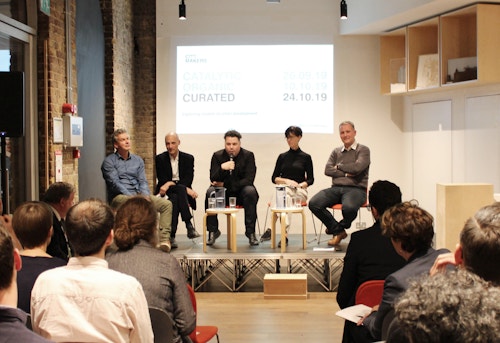/ Citymakers: Curated
Is it possible to curate and control urban development in the long-term through planning and design?
by Alfredo CaraballoOver the autumn of 2019, our Citymakers conference has been examining the contexts within which our masterplans are realised under three headings: catalytic, organic and curated.
The first event discussed the long-term impact of urban catalysts such as the Olympic Games on a city’s evolution; the second took on the question of those places that undergo more spontaneous regeneration. Under the header ‘curated’, the last evening addressed the deliberate design of pieces of city, where uses and outcomes are predetermined – often under the control of a single actor. Partner Alfredo Caraballo, Centre for London founding director Ben Rogers and Robert Evans, executive director of Argent, offered presentations on the topic with the case study of King’s Cross as a starting point to which Helen Goodwin, on behalf of Public Practice and Jason Prior, founding partner at Prior + Partners offered responses.
Alfredo kicked off the discussion by mulling on the notion of curation as an art and an act. With its origins in museum collections, it nowadays is used to describe the careful management and cataloguing of all manner of things, from travel experiences to food, often employed in the context of masterplanning. Curation then, is the process of organising and looking after a place. At King’s Cross, the aspirations for the project were captured in ten urban principles that guided it on the one hand and on the other, these were expressed in drawings of public spaces. By specifying an end goal from the outset, while allowing for flexibility to adjust for the incidental in the interim, the masterplan was able to bridge the certainty needed by public authorities as well as the amount of elasticity required by the market.
Planning in Britain is a discretionary process that could be interpreted as having a curated approach, Ben Rogers offered in his presentation. He provided a bigger picture of planning and development in London and the UK. In comparison to the rules-based planning system on the Continent or in the United States, decisions here are made on a case to case basis. At least four levels of decision-making powers, from the national government to neighbourhood forums add to the rich complexity of the resulting cityscape.
As developer of King’s Cross, Robert Evans of Argent gave the inside story into how the project came about and has been carried out. He shared Argent’s experience in crafting the space, especially the tenant mix, noting that probably the most ‘curated’ space is Coal Drops Yard, where experiences, encounters and entertainment shape the personality of the space. The team at Argent shaped the arrival experience and over time, they have learned ‘on the job’ so to speak, by adapting their approach to management of the public spaces and the use of pop-up spaces. Robert asked the audience if developers were indeed the new entertainers, and with this expectation, significant urban projects will require ever more sophisticated degrees of programming.
While Helen Goodwin saw King’s Cross as an exemplar for local authorities partnering with a developer to get the plan right, Jason Prior challenged the idea of a holistic commitment around place, space and structure to include the health and wellbeing of a community. In the ensuing discussion on the role of architecture, Alfredo made a distinction between what architecture can and cannot achieve in the context of contemporary urban developments. While the need for a developer to provide urban services poses a new challenge, the content generated can give real purpose and meaning to new places, and good design by itself may not be enough.
